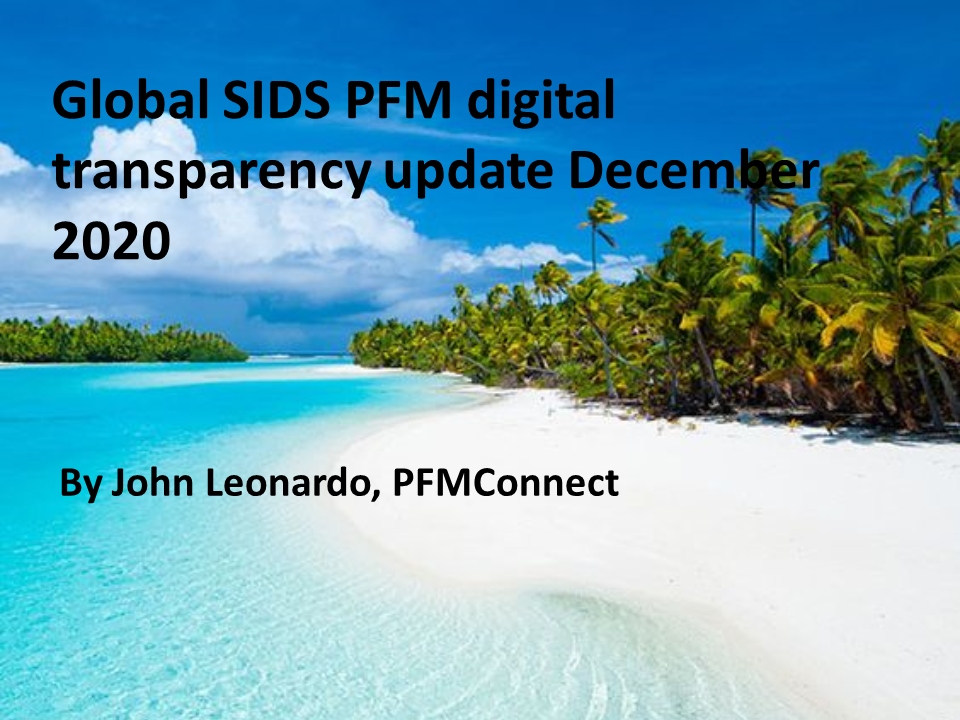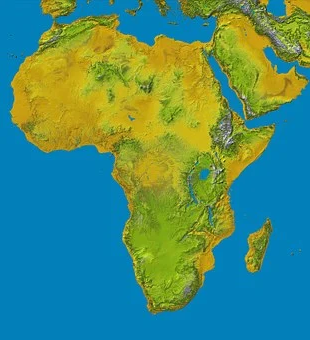Global SIDS PFM digital transparency update

Our June 2020 video “Improving PFM digital transparency in SIDS finance ministries” examined finance ministries (MoFs) use of digital platforms such as websites and social media to provide public financial management (PFM) related information in small island developing states (SIDS). In this “Global SIDS PFM digital transparency update December 2020” video recent SIDS PFM digital transparency trends are examined on a regional and country basis.
Regional PFM digital transparency analysis
Global SIDS PFM digital transparency trends have been analysed using the following regional classifications for countries where MoF websites were active:
- Africa/Asia/Middle East (7 countries)
- Caribbean (18 countries)
- Pacific (11 countries)
Non-active SIDS MoF websites in the 2020 September quarter in the above-mentioned regions were as follows:
- Africa/Asia/MiddleEast (3 countries)
- Caribbean (11 countries)
- Pacific (8 countries)
Charts for the following indicators are presented:
- MoF website penetration levels for the 2020 March and September quarters. The figures used in these charts were obtained using a two-step process. Actual visit data for the March and September 2020 quarters was annualised to provide projections of estimated 2020 visits. The resulting 2020 annual MoF website visit projections were divided by the number of country internet users to obtain MoF website penetration levels.
- Domestic and non-resident visits to MoF websites for the 2020 March and September quarters; these charts reflect the percentage of visits to MoF websites attributable to local residents and non-residents in the 2020 March and September quarters based on actual visit data.
- Rates of change in MoF website visits; this data is based on changes to MoF visit levels between the 2020 March and September quarters.
- MoF Facebook penetration levels as at June 2020 and October 2020; these figures were obtained by dividing actual MoF Facebook follower numbers by the number of country Facebook subscribers.
- Changes in Facebook follower numbers between June 2020 and October 2020; these charts reflect changes in the respective MoF Facebook follower numbers.
- MoF Twitter penetration levels as at October 2020; these figures were obtained by dividing actual MoF Twitter follower numbers by the number of country Twitter subscribers.
- Changes in Twitter follower numbers between June 2020 and October 2020; these charts reflect changes in the respective MoF Twitter follower numbers.
The above-mentioned regional analyses are also available here:
- Africa/Asia/Middle East
- Caribbean
- Pacific
Key regional analysis findings
Some of our key findings from the regional analysis are as follows:
- Increases were recorded in SIDS overall regional MoF penetration scores for SIDS MoF websites, SIDS Facebook followers and SIDS Twitter followers. This growth is partially attributable to MoF posts relating to COVID-19 topics.
- A material increase in the SIDS Caribbean MoF Twitter follower penetration score contributed to strong growth in the SIDS overall regional Twitter follower penetration score.
- The increased interest in MoF digital platforms also resulted in material increases in the proportion of MoF website visits attributable to local residents and a consequent reduction in the proportion of MoF website visits attributable to non-residents. This trend was particularly evident in the Pacific where there was strong growth in Papua New Guinea MoF local resident visits.
- In four of the SIDS countries with MoF Facebook pages, the number of Facebook followers exceeded estimated 2020 MoF website visits demonstrating the role social media can play in boosting transparency about SIDS MoF activities.
SIDS country PFM digital transparency analysis
SIDS PFM digital transparency trends have also been analysed for the 36 countries examined in the above-mentioned regional analysis.
Country charts presenting the following PFM digital transparency indicators are available:
- MoF website penetration levels for the 2020 September quarter. The figures used in these charts were obtained using a two-step process. Actual visit data for the September 2020 quarter was annualised to provide projections of estimated 2020 visits. The resulting 2020 annual MoF website visit projections were divided by the number of country internet users to obtain MoF website penetration levels.
- Domestic and non-resident visits to MoF websites for the 2020 September quarter; these charts reflect the percentage of visits to MoF websites attributable to local residents and non-residents in the 2020 September quarter based on actual visit data.
- MoF Facebook penetration levels as at October 2020; these figures were obtained by dividing actual MoF Facebook follower numbers by the number of country Facebook subscribers.
- MoF Twitter penetration levels as at October 2020; these figures were obtained by dividing actual MoF Twitter follower numbers by the number of country Twitter subscribers.
Each country chart presents the following results for each indicator: the available country results, the average regional score and the average score for all SIDS countries where a MoF website was available.
Analyses of trends in key country PFM digital transparency indicators are also available here:
- Africa/Asia/Middle East
- Caribbean
- Pacific
